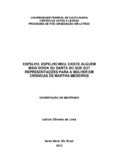| dc.creator | Lima, Letícia Oliveira de | |
| dc.date.accessioned | 2015-06-10 | |
| dc.date.available | 2015-06-10 | |
| dc.date.issued | 2015-02-27 | |
| dc.identifier.citation | LIMA, Letícia Oliveira de. Mirror mirror on the wall, is there anybody craziest or holiest than me? Representations for women in Martha Medeiros` chronicles. 2015. 185 f. Dissertação (Mestrado em Letras) - Universidade Federal de Santa Maria, Santa Maria, 2015. | por |
| dc.identifier.uri | http://repositorio.ufsm.br/handle/1/9922 | |
| dc.description.abstract | This work aims to investigate through the analysis of contextual, lexicogrammatical and semantic-discursive elements the representations for women in chronicles of the book Doidas e Santas by Martha Medeiros. Therefore, it is based on the theoretical perspective of Systemic Functional Linguistics, particularly on the experiential ideational metafunction and interpersonal metafunction of the Systemic Functional Grammar (HALLIDAY; MATTHIESSEN, 2014) and on Appraisal System (MARTIN; WHITE, 2005). The corpus of this research consists of 20 chronicles of the book Doidas e Santas by Martha Medeiros. The methodological approach consisted of two steps: contextual analysis and linguistic analysis. The first referred to the contextual information that pervades the texts from the corpus. The second referred to the following methodological steps: a) segmentation of the texts into clauses; b) selection of clauses concerning women; c) classification of clause elements into process, participant and circumstance; d) identification and analysis of lexicogrammatical functions played by woman, followed by the interpretation of the data obtained from this analysis in search of representations; e) verification and analysis of occurrences of appraisal; and f) categorization of the representations for women from the data obtained in the analysis. The results of the analysis of the chronicles that constitute the corpus pointed to the existence of 13 representations for women, which were systematically presented from five daily themes found in these chronicles: i) loving relationship; ii) physical appearance; iii) maternity; iv) expression of desires and v) expression of feelings. With these results, we can conclude that there is a diversity of women's behaviors that constitute different ―types‖ of contemporary women, but all still somewhat constrained by socially established standards. | eng |
| dc.format | application/pdf | por |
| dc.language | por | por |
| dc.publisher | Universidade Federal de Santa Maria | por |
| dc.rights | Acesso Aberto | por |
| dc.subject | Linguística sistêmico-funcional | por |
| dc.subject | Representações | por |
| dc.subject | Crônica | por |
| dc.subject | Mulher | por |
| dc.subject | Systemic functional linguistics | eng |
| dc.subject | Representations | eng |
| dc.subject | Chronicle | eng |
| dc.subject | Women | eng |
| dc.title | Espelho, espelho meu, existe alguém mais doida ou santa do que eu? Representações para a mulher em crônicas de Martha Medeiros | por |
| dc.title.alternative | Mirror mirror on the wall, is there anybody craziest or holiest than me? Representations for women in Martha Medeiros` chronicles | eng |
| dc.type | Dissertação | por |
| dc.description.resumo | Este trabalho tem como propósito principal investigar, por meio da análise de elementos contextuais, léxico-gramaticais e semântico-discursivos, representações para a mulher em crônicas do livro Doidas e Santas de Martha Medeiros. Para isso, embasou-se na perspectiva teórica da Linguística Sistêmico-Funcional, sobretudo nas metafunções ideacional experiencial e interpessoal da Gramática Sistêmico-Funcional (HALLIDAY e MATTHIESSEN, 2014) e no Sistema de Avaliatividade (MARTIN e WHITE, 2005). O corpus desta pesquisa é constituído por 20 crônicas do livro Doidas e santas, de autoria de Martha Medeiros. O percurso metodológico foi composto por duas etapas: análise contextual e análise linguística. A primeira referiu-se às informações contextuais que perpassam os textos do corpus. A segunda referiu-se aos seguintes passos: a) segmentação dos textos em orações; b) seleção das orações que se referem a mulher; c) classificação dos constituintes oracionais em processo, participante e circunstância; d) identificação e análise das funções léxico-gramaticais desempenhadas pela mulher, seguida da interpretação dos dados obtidos dessa análise em busca de representações; e) verificação e análise de ocorrências de avaliatividade e f) categorização das representações para a mulher a partir dos dados obtidos na análise. Os resultados da análise das crônicas que constituem o corpus apontaram para existência de 13 representações para a mulher, as quais foram apresentadas sistematicamente a partir dos cinco temas do cotidiano encontrados nessas crônicas: i) relacionamento amoroso; ii) aparência física; iii) maternidade; iv) manifestação de desejos e v) manifestação de sentimentos. Com esses resultados, pode-se concluir que há uma diversidade de comportamentos femininos os quais configuram diferentes ―tipos‖ de mulheres contemporâneas, mas todas ainda, de certa forma, condicionadas por padrões estabelecidos socialmente. | por |
| dc.contributor.advisor1 | Fuzer, Cristiane | |
| dc.contributor.advisor1Lattes | http://lattes.cnpq.br/5169963931397212 | por |
| dc.contributor.referee1 | Silva, Edna Cristina Muniz da | |
| dc.contributor.referee1Lattes | http://lattes.cnpq.br/3082159562604784 | por |
| dc.contributor.referee2 | Pinton, Francieli Matzenbacher | |
| dc.contributor.referee2Lattes | http://lattes.cnpq.br/1979338178408389 | por |
| dc.creator.Lattes | http://lattes.cnpq.br/4571462885743266 | por |
| dc.publisher.country | BR | por |
| dc.publisher.department | Letras | por |
| dc.publisher.initials | UFSM | por |
| dc.publisher.program | Programa de Pós-Graduação em Letras | por |
| dc.subject.cnpq | CNPQ::LINGUISTICA, LETRAS E ARTES::LETRAS | por |


